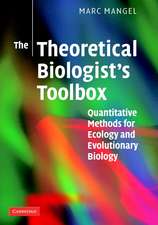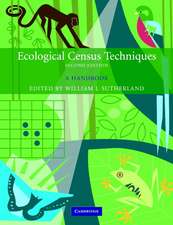Code Biology: A New Science of Life
Autor Marcello Barbierien Limba Engleză Hardback – 3 mar 2015
| Toate formatele și edițiile | Preț | Express |
|---|---|---|
| Paperback (1) | 942.31 lei 6-8 săpt. | |
| Springer International Publishing – 6 oct 2016 | 942.31 lei 6-8 săpt. | |
| Hardback (1) | 942.90 lei 6-8 săpt. | |
| Springer International Publishing – 3 mar 2015 | 942.90 lei 6-8 săpt. |
Preț: 942.90 lei
Preț vechi: 1149.88 lei
-18% Nou
Puncte Express: 1414
Preț estimativ în valută:
180.43€ • 192.94$ • 150.43£
180.43€ • 192.94$ • 150.43£
Carte tipărită la comandă
Livrare economică 18 aprilie-02 mai
Preluare comenzi: 021 569.72.76
Specificații
ISBN-13: 9783319145341
ISBN-10: 3319145347
Pagini: 224
Ilustrații: XXI, 224 p. 2 illus.
Dimensiuni: 155 x 235 x 20 mm
Greutate: 0.53 kg
Ediția:2015
Editura: Springer International Publishing
Colecția Springer
Locul publicării:Cham, Switzerland
ISBN-10: 3319145347
Pagini: 224
Ilustrații: XXI, 224 p. 2 illus.
Dimensiuni: 155 x 235 x 20 mm
Greutate: 0.53 kg
Ediția:2015
Editura: Springer International Publishing
Colecția Springer
Locul publicării:Cham, Switzerland
Public țintă
ResearchCuprins
Acknowledgments
Introductory Chapter.- The Life and Education of Jakob von Uexküll. The Basis of the Environmental Theory.- The Subjective World of the Umwelt.- The Structure of the Umwelt.- Environment and Meaning.- Influences and Interpretations of the Work of Uexküll.- Conclusion. References.- Index.
Introductory Chapter.- The Life and Education of Jakob von Uexküll. The Basis of the Environmental Theory.- The Subjective World of the Umwelt.- The Structure of the Umwelt.- Environment and Meaning.- Influences and Interpretations of the Work of Uexküll.- Conclusion. References.- Index.
Recenzii
“Barbieri (embryology, Univ. of Ferrara, Italy) laysout the case for multiple codes, each corresponding with, and instrumental inthe origin of, different levels of biological organization: from the origin oflife (genetic), the three kingdoms of life (signal transduction), the nucleus(splicing code), regulation of eukaryotic genomes (histone code), cell division(the cytoskeletal code), to mind and language (the organic code). … Summing Up:Recommended. Upper-division undergraduates, graduate students, andresearchers/faculty.” (B. K. Hall, Choice, Vol. 53 (1), September, 2015)
Notă biografică
Marcello Barbieri (born 1940) is professor of embryology at the University of Ferrara, Italy. He has conducted research on embryonic development and ribosome crystallization at the Medical Research Council in Cambridge, UK, the National Institutes of Health in Bethesda, USA, and the Max-Planck-Institut für Molekulare Genetik in Berlin. He has published books on embryology and evolution, and has taught biophysics, molecular embryology and theoretical biology respectively at the Universities of Bologna, Sassari and Turin. His research interests include embryology, evolution and biosemiotics. He is Editor-in-Chief of the journal Biosemiotics, was a co-Editor of the Springer Book Series in Biosemiotics.
Textul de pe ultima copertă
The genetic code appeared on Earth at the origin of life, and the codes of culture arrived almost four billion years later. For a long time it has been assumed that these are the only codes that exist in Nature, and if that were true we would have to conclude that codes are extraordinary exceptions that appeared only at the beginning and at the end of the history of life. In reality, various other organic codes have been discovered in the past few decades and it is likely that more will come to light in the future. The existence of many organic codes in Nature is therefore an experimental fact, but also more than that. It is one of those facts that have extraordinary implications. In this book it is shown that the genetic code was a precondition for the origin of the first cells, the signal transduction codes divided the first cells into three primary kingdoms (Archaea, Bacteria and Eukarya), the splicing codes were instrumental to the origin of the eukaryotic nucleus, the histone code provided a new regulation system in eukaryotic genomes, and the cytoskeleton codes allowed the Eukarya to perform internal movements, including those of mitosis and meiosis. It is shown, furthermore, that organic codes had a key role in multicellular life, in particular in the origin of animals, the origin of mind and the origin of language. The great events of macroevolution, in other words, were associated with the appearance of new organic codes,and we can easily understand why. The reason is that a new code brings into existence something that has never existed before because it creates arbitrary associations, relationships that are not determined by physical necessity. Another outstanding implication is the fact that codes involve meaning and we need therefore to introduce in biology, with the standard methods of science, not only the concept of biological information but also that of biological meaning. The research on biological codes, in conclusion, is bringing to light new mechanisms in evolution and new fundamental concepts in science. This research is the field of Code Biology, the study of all codes of life, from the genetic code to the codes of culture, from the origin of life to the origin of man.
Caracteristici
It is of interest in virtually all research fields of the life sciences because it shows that biological codes exist at all levels in all living systems It provide evidence for a new paradigm that goes beyond the popular views in macroevolution proposed by Stephen Jay Gould (2002) and by Maynard Smith and Szathmáry (1995) It is accessible to a wide audience















